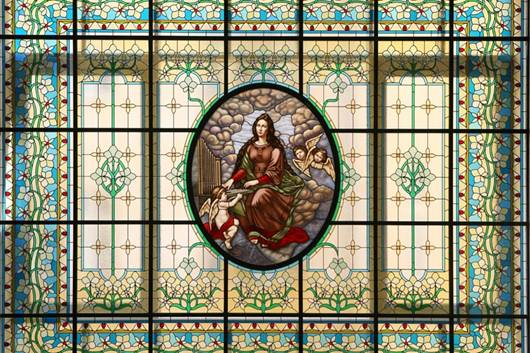

Saint Cecilia (Latin: Caecilia Romana, Italian: Cecilia a Roma) – or St. Cecilia the Roman (approx. 200–230 AD) was an early Christian virgin saint and martyr. She is usually depicted with a sword and a rose, standing next to a keyboard (organ, harpsichord) or bowed string instrument. Her name is mentioned in the Eucharist Prayer in the Canon of the Roman Catholic Church.
St. Cecilia has been honored as a patron saint of church music since the 16th century. According to the Holy Tradition, she prayed to God and sang sacred chants as she was being led to the altar on her wedding day. Later an angel descended to the bridegroom and bride and placed wreaths of roses and lilies on their heads. These flowers are usually considered to present the attributes of Saint Cecilia, as are various musical instruments, most often, keyboard (pipe organ, harpsichord or celesta) or bowed stringed ones (viols).
St. Cecilia was born into a family of Roman aristocrats and came to believe in our Lord Jesus Christ from the time of her youth. Thereby, the main object of her life was service to the needy and the inclination to remain pure and chaste until her death. When her parents decided to marry her to the noble Roman, Valerian, the girl did not attempt to contradict them, but merely prayed for God’s help. She was successful in bringing her fiancé to belief in Christ. Soon after that, Valerian’s brother Tiburtius was also converted to Christianity. The young people helped the poor and needy in all sorts of ways. They were not afraid of suffering persecution. Valerian and Tiburtius were subsequently executed for their faith, and during that time St. Cecilia was able to give away the remainder of her possessions and to convert four hundred Romans to the faith of Christ. At first, the executioners tried to kill her in scorching-hot baths, but St. Cecilia remained alive. Then they tried to kill her with a sword, but the executioner was not able to cut off the girl’s head, but merely inflicted mortal wounds onto her. After this, St. Cecilia lived three days more, steadfastly confessing the Christian faith.
The Christians buried St. Cecilia’s body in the Roman catacombs and prayed over them for centuries. In the 9th century A.D. Pope Pascalius I solemnly transferred the relics of the saint from out of the catacombs and placed them within the St. Cecilia Church in Trastavere (on the other side of the Tiber River), making orders that her head be preserved at the Santi Quattro Coronati monastery. However, when in 1599 the relics were disclosed, the head was discovered to be together with the body. Those who were present during the disclosure of the relics testified that they had not decayed. Sculptor Stefano Maderno, who took part in disclosing the relics, imprinted the image of Cecilia’s body seen by him in a marble statue he created, which is presently located in the Santa Cecilia church in Trastevere.
The image of St. Cecilia has frequently inspired painters to replicate it, which has been done by such masters as Rafaello Santi, Artemisia Gentileschi, Carlo Dolci, John Melhuish Strudwick, Niccolò Renieri, Guido Reni, Matteo Rosselli and John Waterhouse.
In the 16th century composer Giovanni Pierluigi Palestrina established a society for development of sacred music in Rome, bearing the name “Brotherhood of St. Cecilia.” Pope Pius IX transformed this society into an Academy and instituted the order of perfection for its members. It is presently called the Santa Cecilia National Academy. Many musicians from Italy and other countries have become its actual and honored members. The Academy hosts a symphony orchestra, a museum and a research music library.
A number of well-known musical compositions have been written in honor of St.Cecilia, including the “Odes for St. Cecilia’s Day” by Henry Purcell (1659–1695) and by George Frederic Handel (1685–1759).
The negatives of photographs of the old stained glass have been preserved in the Nikolay Grigor’yevich Rubinstein Museum, and the specimens of the glass have been preserved in the workshops of “MOSPROEKT N.2”.
The restoration of the stained glass included the participation of S.V. Kuner, I.B. Antonenko, A.V. Volodina (from the Closed Auction Society “BALTSTROI”), A.E. Mikhailenko (from Federal State Unitary Enterprise “ATEX” and the Russian Federal Service for Protection), A.A. Berstein (from “MOSPROEKT N.2” and Workroom N.13), V.N. Lebedev, O.I. Lebedeva, E.O. Visser, E.O. Chepurov and A.S. Nikolayev (from the Stained Glass Studio of Vadim Lebedev in St. Petersburg).